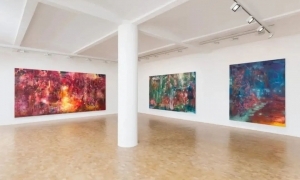“它在大草原上又鋪開了一道沉著的
陰影,然而為它命名,
推想它的環(huán)境、這行為己經(jīng)
變成了藝術(shù)的虛構(gòu)”[i]
博爾赫斯在《另一只老虎》中歌頌與尋覓的老虎具有永時(shí)性,這首寫于1958年的詩(shī)歌在50年后與中國(guó)當(dāng)代藝術(shù)家傅榆翔的油畫作品《天空沒有回音NO.1》不謀而合。那首預(yù)言與寓意性質(zhì)并重的詩(shī)歌幾乎可作為傅榆翔這幅作品的最好闡釋。闡釋先于創(chuàng)作而存在,我們看到博爾赫斯的精神能量沐浴著詩(shī)性的光輝,從光怪陸離的南美洲大陸直接導(dǎo)入“一個(gè)不斷增高的亞洲”腹地,在中國(guó)重慶那片山水奇崛之地降臨,傅榆翔的創(chuàng)作獲得了先驗(yàn)性的啟示。
為動(dòng)物書寫心靈與歷史,這個(gè)企圖在偉大的創(chuàng)作家那里并不鮮見:莊子寫下巨鯤、飛舞的蝴蝶;李賀寫下瘦馬;蒲松齡寫了狐貍。再放眼西方:卡夫卡寫了甲蟲,他變成一只甲蟲;梅特林克寫了青鳥,青鳥在他筆下飛走和消失;還有麥爾維爾的白鯨、??思{的熊、杰克•倫敦的狼、法布爾的昆蟲、愛倫坡的烏鴉和貓、史蒂文斯的黑鳥、安徒生的美人魚。例子不勝枚舉,就連盲目的老荷馬也曾吟唱到海中人魚,他甚至認(rèn)為,人魚的美妙歌聲遠(yuǎn)勝過(guò)他自己的豎琴。
傅榆翔一定是帶著自己觀看死亡的經(jīng)驗(yàn)上路的,他描繪了一只巨大的、充盈于天地之間的鴨:栩栩如生卻又死于非命,毛羽褪盡——酷似要告慰肚腸之前,拎來(lái)給食客驗(yàn)身的一瞥!
這“臨終的一瞥”因?yàn)閯?dòng)物那似閉非閉的眼神而具有觀看上的互動(dòng),動(dòng)物的悲天憫人情懷呼之欲出,其獻(xiàn)身精神似乎是畫家本人的內(nèi)心寫照。在北京民謠歌者周云篷那里我曾經(jīng)看到相同的詠物范式,但后者更多的是自怨自艾,是對(duì)“煮熟的鴨子要飛走,落魄京城究可哀”[ii]的反復(fù)詠唱。
人與動(dòng)物的交流在傅榆翔這里達(dá)到一個(gè)臨界值,當(dāng)動(dòng)物赤裸于天地間與人相對(duì)時(shí),是誰(shuí)上了天堂?傅榆翔沒有給出答案,他指稱與命名說(shuō):“天空沒有回音”。這個(gè)具有宗教使命的“非宗教畫家”,其內(nèi)心顫動(dòng)的音符至此嘎然停頓,如一記當(dāng)頭棒喝后的寧?kù)o與虛無(wú)。
事物在流淌,藝術(shù)在虛構(gòu)。虛構(gòu)的筆法之中,所獲取的“逼真”卻更加強(qiáng)大、更加內(nèi)省。虛構(gòu)的敘事美學(xué)直接搗入“逼真”的命門。是逼真而非真實(shí),逼近最真實(shí)的真實(shí)遠(yuǎn)比表象上的真實(shí)更接近真理,也更具有說(shuō)服性。澳大利亞漢學(xué)家西蒙·黎斯說(shuō):“事實(shí)本身只提供一種無(wú)意義的混亂,只有藝術(shù)創(chuàng)造由于它們具有了形式和節(jié)奏才能賦予其意義?!薄跋胂笏鸬牟粌H僅是美學(xué)功能——它的作用也是倫理的。不折不扣地說(shuō),真實(shí)必須是創(chuàng)造出來(lái)的?!?A title="" href="http://m.djkxsd.cn/Manage/along/ewebeditor.asp?id=Content&style=mystyle#_edn3" name=_ednref3>[iii]
在過(guò)分放大尺寸的動(dòng)物與對(duì)山水的鋪墊性描摹之間,傅榆翔找到了遵循自己內(nèi)心尺度的形式,這種形式不是令人不安的,而是卡夫卡式的“保持完全的安靜和孤獨(dú)”,亦如四川詩(shī)人陳冰所言:“如一滴水珠,附掛于人群之外安寧”[iv]??ǚ蚩ㄟ@樣說(shuō):“你沒有走出屋子的必要。你就坐在你的桌旁傾聽吧。甚至傾聽也不必,僅僅等待著就行。甚至等待也不必,保持完全的安靜和孤獨(dú)好了。這世界將會(huì)在你面前蛻去外殼,它不會(huì)別的,它將飄然地在你面前扭動(dòng)?!?A title="" href="http://m.djkxsd.cn/Manage/along/ewebeditor.asp?id=Content&style=mystyle#_edn5" name=_ednref5>[v]
我們清晰的意識(shí)到,傅榆翔的動(dòng)物觀與世界觀達(dá)成一致,在同一個(gè)精神維度上:動(dòng)物(亦即世界)在他面前蛻去外殼。它不會(huì)別的,它在觀者的面前飄然地扭動(dòng)。
這決非一個(gè)來(lái)自我的簡(jiǎn)單判定,在普通觀眾假想傅榆翔是一個(gè)動(dòng)物保護(hù)者、素食主義者、環(huán)境保護(hù)者時(shí),他的內(nèi)心其實(shí)走得更遠(yuǎn)?!吧酱ǘ苷Z(yǔ),葬師食無(wú)所?!?A title="" href="http://m.djkxsd.cn/Manage/along/ewebeditor.asp?id=Content&style=mystyle#_edn6" name=_ednref6>[vi]正是因?yàn)樯酱ú徽f(shuō)話,傅榆翔所構(gòu)筑的“動(dòng)物山水”才獲得一種死亡賦格,在賦格的節(jié)奏中,我們能傾聽、等待到他筆觸間“潤(rùn)物細(xì)無(wú)聲”的哀愁與悲憫。
“他叫道更甜蜜地和死亡玩吧死亡是從德國(guó)來(lái)的大師
他叫道更低沉一些現(xiàn)在拉你們的琴爾后你們就會(huì)
化為煙霧升在空中
爾后在云彩里你們就有一個(gè)墳在那里不擁擠”[vii]8
觀看《天空沒有回音NO.1》的有限經(jīng)驗(yàn),讓我聯(lián)想起這首保羅·策蘭的《死亡賦格》,傅榆翔內(nèi)心的形式與韻律至此昭然若揭。
事實(shí)上,這幅作品在世界藝術(shù)史的范疇中,仍能找到佐證。它強(qiáng)烈地借鑒了超現(xiàn)實(shí)主義類型,并將之運(yùn)用到中國(guó)山水意象的傳統(tǒng)結(jié)構(gòu)中,在技法上層疊演進(jìn)、沾染并蓄,以墨色烘托于條幅之間,從而完成了傅榆翔的“動(dòng)物山水”之典范:在突兀之中制造寧?kù)o、在靜默之中制造觀看狀態(tài)下的壓力。
我們不會(huì)忘記,由詩(shī)人阿拉貢和畫家恩斯特等人在1925年發(fā)布的超現(xiàn)實(shí)主義宣言中說(shuō):“我們不主張改變社會(huì)道德觀,但我們企圖證明思想之脆弱性,和展示在此基礎(chǔ)、洞穴上面建筑危樓之后果?!?A title="" href="http://m.djkxsd.cn/Manage/along/ewebeditor.asp?id=Content&style=mystyle#_edn8" name=_ednref8>[viii]
傅榆翔的繪畫與思想之境,亦通過(guò)這幅作品,達(dá)到了一個(gè)令人贊許的高度,也由此使他能夠從當(dāng)代藝術(shù)家群體中被清晰地指認(rèn)出來(lái)。
2008年3月2日
寫于北京
i.老虎的意象貫穿著阿根廷作家博爾赫斯的一生,在博氏的詩(shī)歌和小說(shuō)里多次被描述。從最早的《另一只虎》,到《萌中的老虎》、《老虎的金黃》、《藍(lán)虎》、《最后的老虎》,這位美洲虎圖騰的崇拜者不厭其煩。
ii.周云蓬,《中國(guó)孩子》專輯,2007。
[1] 見喬治·奧威爾《我為什么要寫作》之前言,董樂(lè)山譯,上海譯文出版社,2007。
[1] 見民刊《漢江潮》,陳冰與友人通信,2000。
[1] 見卡夫卡《誤入世界》,陜西師大出版社,2002。
[1]語(yǔ)見《古詩(shī)源·山經(jīng)引相冢書》。
[1]“死亡賦格”一詩(shī)由流暢的詩(shī)句組成,古希臘韻步與句法結(jié)構(gòu)的關(guān)系和諧統(tǒng)一。該詩(shī)采用“揚(yáng)抑抑格”韻步。一般認(rèn)為,詩(shī)成于1945。
[1] 見《世界藝術(shù)史》,范迪安中文版主編,南方出版社,2002年。
The Contemporary Representative of Animal Landscapes
— An Appreciation of Silence in the Sky NO.1(a series)
By Hu Jiujiu (edt. of New Weekly)
“Throws its shadow on the grass;
But by the act of giving it a name,
By trying to fix the limits of its world,
It becomes a fiction.”1
It becomes a fiction.”1
The tiger Borges glorified and pursued in The Other Tiger is eternal. The poem, composed in 1958, is echoed 50 years later by the Chinese contemporary artist Fu YUxiang’s oil painting Silence is the Sky NO.1. The poem, prophetic and allegorical, may be the best interpretation of the oil painting. Interpretation precedes creation. Borges’s spirit, bathed in the poetic brilliance, flies from a bizarre South America into the rising belly of Asia, landing in mountainous Chongqing and then endowing Fu Yuxiang a transcendental inspiration.
Such attempt to depict animal’s innermost and history is not rare to masters: Chuang Tzu’s description of Kun (a kind of gigantic fish) and fluttering butterflies, Li He’s poem on horses and Pu Songlin’s stories of foxes. It’s the same in the western world: the hero changing into a beetle in Franz Kafka’s fiction, birds flying away and disappearing in Maurice Maeterlinck’s verses, Melville’s whale, Faulkner’s bear, Jack London’s wolf, Fabre’s insect, Allan Poe’s crow and cat, Stevens’s black bird and Andersen’s mermaid, too numerous to mention. Besides, the ancient Homer had ever eulogized the mermaid and even considered her sweet singing over his harp.
Fu Yuxiang must have got his inspiration of painting from his insight into death, then he creates a huge duck permeating the universe: vivid while dying an unnatural death, with not a single feather left — a glimpse of a duck waiting for check-up before catering the appetite.
The last glimpse, by the expression in its half-open eyes, is inviting an interaction, from which the animal’s humanitarian bosom has been vividly portrayed on paper. Such devoting spirit is just a mirror of the artist’s own inner heart. The same style can be found in Beijing-ballad singer Zhou Yunpeng’s song, though the latter is more of remorse, a repeated singing of “ a cooked duck is flying away(what’s sure to gain is lost) , a depressed heart in the capital”.2
Communication between human beings and animals goes critical in this oil painting. Who comes into the paradise when human is confronted with an animal naked in the universe? No answer is presented by the painter who only names it “Silence is the Sky.” Then the inner vibrating notes suddenly suspend in the missioned “unreligious artist”, like the tranquility and nihility after a severe blow.
Life of creature lies in flowing while that of art in fiction. The verisimilitude captured in fictive painting appears more mighty and introspective. The fictive narrative aesthetics approaches directly into the essence of verisimilitude. It is verisimilitude not reality, as the approaching reality is closer to truth and more persuasive than superficial one. As the Australia Sinologist Simon Leese says “Truth itself provides nothing but senseless chaos, and only art, with form and rhythm, can endow it significance.”“Imagination does not only function aesthetically- also ethically. Exactly speaking, reality is creation.”3
In the painting of an over-dimensioned animal landscape, Fu Yuxiang finds a form consistent with his own inner criteria. Such form is not upsetting but the same as Kafka’s “keeping absolute tranquility and solitude”, the same as Chen Bin’s (a poet in Si Chuan province) simile “the tranquility of a drip of water remote from secular world”. 4 Kafka also has it like this “It’s unnecessary to go outside. Sit down at your table and listen. Even listening is unnecessary, just wait. Nor waiting is needed. It’s enough to keep absolute quietness and solitude. The world will remove its disguise in front of you. It’s capable of nothing but dancing for you.5
It’s clear that Fu Yuxiang’s outlook of animal and world are consistent. They co-exist in the same spiritual dimension: the animal (the world) sloughs its skin in front of him. It does nothing but dancing for the spectator.
It is by no means my personal conclusion. His spirit has flied further away while the ordinary considers him as an animal preserver, vegetarian or environmentalist. A Chinese saying goes like this “If the land could tell, those Feng Shui masters (Feng Shui, a practice in China. Feng Shui masters carefully map the nature and flow of energy through buildings and spaces to achieve a good balance of energy for the inhabitants.) would be redundant.”6 It is out of the silence of land that Fu Yuxiang’s “animal landscapes” attain a fugue of death in whose rhyme we are unconsciously carried away by its sorrow and pity.
“He shouts play sweeter death’s music,
Death comes as a master from Germany.
He shouts stroke darker the strings,
and as smoke you shall climb to the sky.
Then you’ll have a grave in the clouds it is ample to lie there.” 7
The appreciation of Silence is the Sky NO.1 reminds me of Paul Celan’s poem Fugue of Death, by which the inner heart of Fu Yuxiang is too clearly revealed.
In fact, the work is still echoed by the world artistic history. It borrows heavily from superrealism and applies it to the conventional structure of Chinese landscape images. In technique, it approaches layer upon layer, combining stippling and dyeing together and taking ink as the foil for scrolls. Therefore, it becomes the model of Fu Yuxiang’s animal landscapes: creating serenity out of loftiness, and pressure out of silence in appreciation.
It will never be forgotten what poet Aragon and artist Ernst, etc. claimed in the superrealism declaration in 1925, “We do not intend to change the social ethics but to prove the fragility of thoughts, so as to predict the consequence of constructing upon such bases.” 8
Fu Yuxiang is shown by the painting to have reached an admirable level in artistic creation and ideology, and in virtue of that, he has been outstanding among the contemporary artists.
Mar. 2nd, 2008
In Beijing
Notes:
1. The tiger was a pervasive image for the Argentine poet Borges. Tiger has been repeatedly mentioned in his poems and novels. From the earliest The Other Tiger, The Golden of Tiger, The Blue Tiger to The Last Tiger, the adorer of American tiger-totem has devoted much.
2. Zhou Yunpeng. Album Chinese Children. 2007.
3. George Orwell (1903-1950). Prelude of Why I Write. Dong Leshan. trans. Shanghai Translation Press. 2007.
4. Letters between Chen Bin and His Friends. from a folk magazine Han Jiang Chao. 2000.
5. Franz Kafka. Essays on Paradox. Shaanxi University Press. 2002.
6. A Collection of Chinese Ancient Poetry
7. Paul Celan. Fugue of Death (1945). in which the ancient Greek rhyme and sentence structure are combined unanimously, is composed of fluent verses in dactyl rhyme.
8. Fan Di’an. A History of World Art. Nan Fang Press. 2002.
【編輯:霍春常】






















